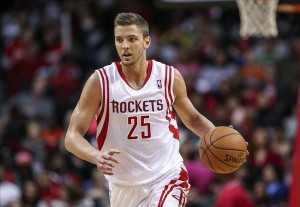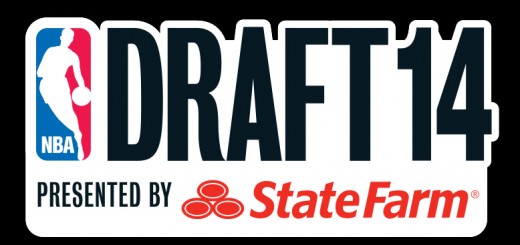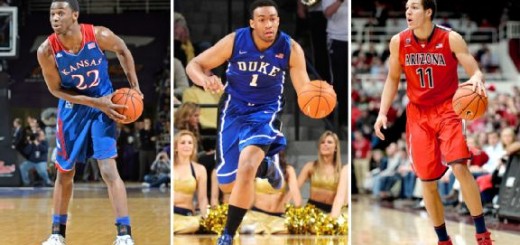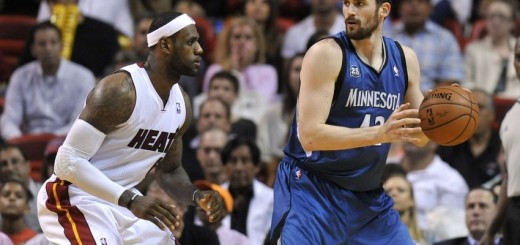Perhaps not entirely lost amidst the LeBron decision and an endless stream of “I’m Coming Home” YouTube montages, was a curious series of events regarding NBA up-and-comer Chandler Parsons. Parsons, a University of Florida alumnus, is a quintessential stretch forward who can shoot lights out from three point range in additional to flashing an all around game. In today’s NBA, such players are uniquely valuable. Due to circumstances described below, Parsons was a restricted free agent this summer. However to understand fully what went on between Parsons, the Rockets and the Dallas Mavericks, a discussion of collective bargaining principles, foolish player agents, and savvy general managers is appropriate. Fair warning, I will attempt to keep the CBA nitty-gritty to a minimum, however some of the details will be important. To begin, Parsons was drafted #38 overall by the Houston Rockets in the 2011 NBA draft. He was a great shooter and player in college but concerns about his athleticism prevented him from being a first round pick.[i] The Rockets, led by general manager Daryl Morey, however believed they had a gem, or at least the potential for a rotation player in Parsons (getting a rotation player in the second round is great value) and thus offered him an intriguing contract. As a second round pick, there is no salary scale and most picks (who are not foreign) end up making at or near the minimum salary on non guaranteed contracts typically for two years. However Houston offered Parsons a four year deal worth nearly double the minimum salary to start and pay increases to nearly one million dollars by the end of the contract. The contract was guaranteed for two years and partially guaranteed beyond that. While it is uncertain whether or not his agent advised Parsons to take this deal, the structure of this deal is extremely team friendly. Before we explain why, we first need a vocabulary lesson -Bird Rights – Refers to the Bird exception which allows teams to go over the salary cap to re sign their own players if those players have either a) been on the same team for the preceding three years; or b) been under the same contract for the preceding three years -“Gilbert Arenas” Rule (No its not anything about prohibitions of guns on planes)– the rule stating that offers to restricted free agents (RFAs) who have less than three years of service must be limited to the mid level exception plus small annual raises for the first two years of the contract to ensure that the teams with rights of first refusal may match any offer sheet even if they are over the cap. -Cap Hold – An amount relating to a team’s unsigned free agents who were on the team the prior season which counts against the teams cap until the player is re signed at a new cap number or renounced. For second round picks or undrafted players, if your contract is up after one, two, or three years in the league you are a restricted free agent. In order to retain the right to match, your original team must make you a qualifying offer (which will be your cap hold number – more on that later). The maximum offer sheet an RFA may sign to attempt to move to a new team must comply with the Gilbert Arenas Rule and may offer a salary structure which will start at the midlevel exception and have a huge jump in year three. Parsons’ contract, and a two and three year minimum salary contract are outlined below as they would look at the time he signed (approximate figures).
| NBA Rookie Contract Options for Second Round Picks/Undrafted Players | ||||
| Scenario 1 | ||||
| Std 2 Year 2d Rd Rookie | ||||
| Year | Age | Salary | Running Total Earnings | Notes |
| 1 | 22 | $ 473,000 | $ 473,000 | |
| 2 | 23 | $ 473,000 | $ 946,000 | RFA |
| 3 | 24 | $ 5,000,000 | $ 5,946,000 | |
| 4 | 25 | $ 5,000,000 | $ 10,946,000 | |
| 5 | 26 | $ 15,000,000 | $ 25,946,000 | |
| 6 | 27 | $ 15,600,000 | $ 41,546,000 | UFA/3rd Contract |
| Total | $ 41,546,000 | |||
| Summary: Sign your third NBA Contract at Age 27 having made approx: $41,546,000 | ||||
| Scenario 2: 3 Year Second Rd Rookie | ||||
| Year | Age | Salary | Running Total Earnings | Notes |
| 1 | 22 | $ 473,000 | $ 473,000 | |
| 2 | 23 | $ 437,000 | $ 910,000 | |
| 3 | 24 | $ 473,000 | $ 1,383,000 | RFA |
| 4 | 25 | $ 15,000,000 | $ 16,383,000 | |
| 5 | 26 | $ 16,050,000 | $ 32,433,000 | |
| 6 | 27 | $ 17,173,500 | $ 49,606,500 | |
| 7 | 28 | $ 18,375,645 | $ 67,982,145 | UFA/3rd Contract |
| Total | $ 67,982,145 | |||
| Summary: Sign your third NBA Contract at Age 28 having made approx: $67,982,145. Year 3 you are worse off than Scenario 1, but better all years after that. | ||||
| Scenario 3: Parsons Type Deal | ||||
| Year | Age | Salary | Running Total Earnings | Notes |
| 1 | 22 | $ 900,000 | $ 900,000 | |
| 2 | 23 | $ 900,000 | $ 1,800,000 | |
| 3 | 24 | $ 900,000 | $ 2,700,000 | |
| 4 | 25 | $ 900,000 | $ 3,600,000 | UFA |
| 5 | 26 | $ 15,000,000 | $ 18,600,000 | |
| 6 | 27 | $ 16,050,000 | $ 34,650,000 | |
| 7 | 28 | $ 17,173,500 | $ 51,823,500 | |
| 8 | 29 | $ 18,375,645 | $ 70,199,145 | 3rd Contract |
| Total | $ 70,199,145 | |||
| Summary: Sign your third NBA Contract at Age 29 having made approx: $70,199,145. You are in a slightly better financial position for years one and two (and maybe three) but then gravely worse off in every year after that. | ||||
As you can see, Parsons agent did a horrible job in allowing Parsons to agree to his rookie deal. At the time, Parsons stood to make just under four million dollars in his first four years in the league. Had Parsons taken a typical second round contract and signed a max offer sheet after his second season (a no brainer for a player of his caliber), Parsons would have made nearly 11 million in the same four seasons and be slotted in for another thirty million in seasons five and six combined. Put another way, the Rockets gambled with about 800k of cap space in guaranteed salary in years one and two of Parsons deal but would stand to save 10 million in cap space over the next two years. Not surprisingly, Parsons switched agents in the middle of his rookie contract.[ii] Smart teams have been on to this method for several years and the Rockets had signed Chase Budinger and Jermaine Taylor to the same lengthy second round contract after the 2010 NBA draft. The Spurs did the same with DeJuan Blair in 2010. Enter the summer of 2014. Parsons had just played his third season under his extremely team friendly rookie contract (one of the best values in the NBA) and had a team option for about 964 thousand dollars for the 2014/2015 season. In a somewhat curious decision, Houston declined that option. Despite rumors that this was a hat tip to Parsons’ agent who also represents Dwight Howard (allowing Parsons to cash in one year sooner), the Rockets did this to keep Parsons as a restricted free agent after year three (although now a RFA not subject to the Gilbert Arenas Rule since Houston had his Bird Rights) as opposed to an unrestricted free agent after year four. However, Houston, which was in a bind for cap space while chasing Chris Bosh could have kept Parsons on the team one more year for a salary of about one million saving precious cap room. Houston still would have had Bird Rights for Parsons and the right to offer him more years and money than any other team in unrestricted free agency after next season. Therefore it would seem the only reason to decline Parsons’ option was to ensure that you could retain him on your team no matter what. Declining the option and making Parsons a RFA put Houston in a delicate position. Parsons cap hold was now equal to that of a player who was drafted #21 overall’s fourth year option year (due rules about qualifying offers) which is about 1.9 million still well below Parsons’ market value. To get Bosh and keep Parsons, Houston would need to get Bosh first using their cap space, and then use the Bird Exception to match any offers on Parsons (they also had to trade Jeremy Lin and Omer Asik to create the cap space for Bosh). Enter everyone’s favorite owner Mark Cuban who made Parsons a max (or close to max) offer sheet with a term of three years starting at about fifteen million dollars which Parsons signed. Houston then had three days from July 10 (the day when NBA free agency contracts may be signed) to match the offer sheet. Having already moved Lin and Asik to make the cap space for Bosh, and subsequently losing out on Bosh, Houston then unfathomably declined to match the large offer sheet for Parsons, letting him go to Dallas for nothing as no sign and trade could be worked out. What doesn’t make sense is this: If Houston knew they would not match a max offer sheet for Parsons, why decline the team option? They could have kept him cheap for one more year and then made their best offer in unrestricted free agency. Given how well Parsons had played and developed, Houston had to know a large offer sheet designed not to be matched was going to come his way and so the only reason to decline the team option was if you were planning on matching any offer sheet. Since Bosh re-signed in Miami while Houston still had time to match the offer, Houston’s decision is even more puzzling. In a turn of fate that Alannis Morissete would enjoy,[iii] Houston was bitten by their own ploy. Just three years ago Houston used aggressive offer sheets to lure Jeremy Lin and Asik to leave New York and Chicago. When Houston signed those offer sheets many teams criticized the deals as “untradeable” the same words Morey used to describe Parsons new deal. The fact is Parsons deal is not untradeable and Morey should know that since he just traded Lin and Asik in the years they are due 15 million dollar balloon payments (under the Gilbert Arenas Rule). Both sides fired parting shots in the aftermath. Parsons has been wonderful on the court and will be great to watch on Dallas. In addition to his fantastic on court play, his two contracts so far in the NBA provide valuable lessons for teams, agents, players, and armchair general managers alike.
[i] http://www.nbadraft.net/players/chandler-parsons - nobody wants to be compared to Luke Walton…. [ii] http://blog.chron.com/ultimaterockets/2013/05/chandler-parsons-switches-to-dwight-howards-agent-to-expand-his-brand/#8217101=0 [iii] Isn’t it Ironic?




How about the possibility that Morey didn’t think that Chandler Bang was worth the bread, thus enticed an in-state rival to shell out an exorbitant amount of money for a shooter that still lacks athleticism while replacing him with a more affordable, athletic wing.
While Ariza can’t stretch the floor like Parsons, there is no doubt that he is a better rebounder, turns the ball over less, and is a far superior defender. For 2/3 the price per year I think Morey made the right choice - Dwight, Ariza, and Beverely form one of the best defensive 1-3-5 combinations in basketball, and with Harden on the other wing I don’t see how another slow of foot perimeter shooter (AKA Chandler Parsons) with ball skills is a better fit than Ariza.
Thanks for reading. The problem here isn’t that Morey didn’t think Parsons was worth what Dallas paid or that Ariza is a better deal. Dallas did overpay, that was the point. The problem with what Houston did is that Morey forced them to make a 15 million dollar decision on Parsons one year before they had to. They could have kept him for one year at about one million and then made whatever they thought was a fair offer in unrestricted free agency next year. Had they done that, they would have saved flexibility and money and kept talent on the team. In other words, Houston could have simply “ran it back” for another year. They could have even signed Ariza anyways after they missed out on Bosh and had both players for this season. Next year, if Parsons got a better offer he could leave, but at least Houston could have put an offer on the table that they were comfortable with (Maybe similar to what Ariza got paid, as the players have nearly identical PER). Additionally, Houston could have offered Parsons a fifth year, something which nobody else could which may have persuaded him to stay on a championship contending team.